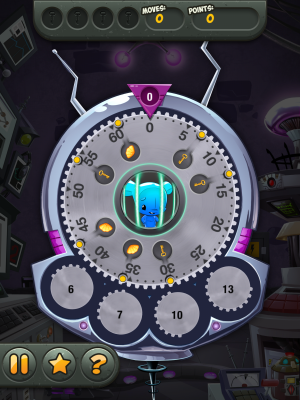In which the word free has several meanings.
SEPTEMBER 3, 2013. As regular readers of this blog will know, I’ve been looking at, thinking about, reflecting on, writing about, and playing video games for many years. I’ve also been working on creating my own video games, working with a small group of highly talented individuals at a company I co-founded a couple of years ago, InnerTube Games, to create high quality casual games that embody mathematical concepts and procedures in a fundamental way.
[ADDED LATER: We renamed the company BrainQuake (brainquake.com) ]
Earlier this year, in an article in American Scientist magazine, I said a little bit about the simple (though to some surprising) metaphor for learning mathematics that guides our design, and provided a screen-shot first glimpse of our pending initial release: Wuzzit Trouble. I also discussed a few other video games that adopted a similar approach to the design of games designed to develop mathematical thinking ability – rather than the rote practice of basic skills that the vast majority of “math ed video games” focus on.

Last week, a bit later than the release date published American Scientist, we were finally able to release our game, Wuzzit Trouble. In our game, the aim is to use increasingly sophisticated analytic thinking to help the cute little Wuzzit characters break free from the traps they have got caught in.
When the game broke free from Apple’s clutches, a free download was all that was required for players from ages 8 to 80 to get to work freeing the Wuzzits. That’s three uses of “free”. A fourth was our approach broke free of the familiar tight binding between mathematical thinking and the manipulation of symbols on a page. (See my February 2012 post on this blog.)
One of our greatest worries was that many people think that mathematical thinking is the manipulation of symbols on a page according to specific rules. (My Stanford colleague, Professor Jo Boaler, has studied this phenomenon. See for example, my account of her work in an article for the Mathematical Association of America.) For anyone with that view, our game would not appear to offer anything particularly new or different. That would mean they would fail to grasp the power of our design metaphor, as I had described in my American Scientist article and in a short video (3 min) we released at the same time as the game.
That will likely be a problem we continue to face. It will, I fear, mean that some people we would like to reach will dismiss our game. (On one remarkable occasion, an anonymous reviewer of a funding application we submitted to cover the development costs of our game, after playing an early prototype, declared that there was not enough mathematical content. All I can say to anyone who thinks that is, give the game a try and see how far you get – see later for the fine print that accompanies that challenge.)
Fortunately, the first review of our game, published in Forbes on the day Apple released it in the App Store, was written by an educational technology writer who understood fully what we are doing. That initial review set the tone for many follow-up articles. We were off to a good start.
We were also greatly helped by Apple’s decision to feature our game, which appeared front and center on the App Store website for educational apps.

Other websites that track and report on the apps world followed suit, and before long we found ourselves in the Top Fifty of new educational apps. People seemed to “get it.”
Presenting a mathematics video game that does not have equations, formulas, or other symbolic mathematics all over the screen is just one way we are different from the vast majority of math learning games. Another is that we built the game to allow players of different ages and mathematical abilities to be able to enjoy the game.
As I describe at the end of another short video, if all you want to do is free all the Wuzzits, all you need is basic whole number arithmetic, which means the game can provide a young child lots of practice with basic number work.
But if someone older wants to get lots of stars and bonus points as well, much more effort is required. (Just check out the solution to one of the puzzles I describe on that video.) This is what we mean when we say Wuzzit Trouble provides a challenge to any player between the ages 8 and 80.
But this is already way too much text. Writing about video games is like writing movie reviews. Both are designed to be experienced, not read about. Just download the game and try it for yourself. And if you are so inclined, take me up on The Math Guy Challenge.
For more details about InnerTube Games and Wuzzit Trouble, visit our website: http://innertubegames.net.

I downloaded this for my (8-year-old) daughter the day it came out. She’s had fun with it so far – thank you and the InnerTube team for developing it!
LikeLike
You are great mathematician , You taught me mathematical thinking on coursera . Ever since my thinking change. Love to hear more from you sir.
LikeLike